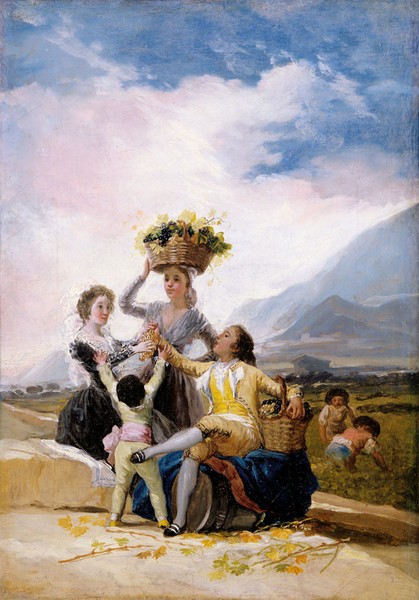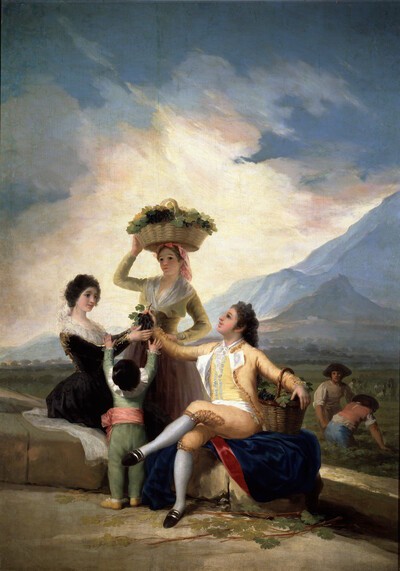- Cronología
- 1786
- Ubicación
- Sterling and Francine Clark Art Institute, Williamstown, United States
- Dimensiones
- 34.4 x 24.3 cm
- Técnica y soporte
- Oil on canvas
- Reconocimiento de la autoría de Goya
- Attributed work
- Titular
- Sterling and Francine Clark Art Institute
- Ficha: realización/revisión
- 09 Dec 2009 / 14 Jun 2023
- Inventario
- (1955.749)
- Otros títulos:
-
The Grape Harvest (La vendimia)
This sketch was acquired by the ninth Duke of Osuna in 1799. The ducal household put it on sale and it was bought by Baron Charles-Jean-Marie Alquier, of Versailles. It was later inherited by Baron René (?) Alquier, who sold it to the collection of Knoedler & Co., New York. Robert Sterling Clark bought it in March 1939 for his collection based in Upperville, Virginia, and from there it entered the collection of the Clark Art Institute when this museum opened its doors in 1955.
The sketch for Autumn is shrouded in a great deal of confusion. Although several of the sketches that Goya made were sold to the ninth Duke of Osuna, and in that sale the four seasons were mentioned, Yriarte reports this piece's absence from said collection when he had the opportunity to visit it before it was sold off due to the bankruptcy of the ducal household. The same writer suggested that the missing sketch was actually one held by the Goupils in their Paris collection, after they had acquired it from Ángel Tadeo. The whereabouts of this sketch are today unknown and it is very different from the one conserved in Williamstown, since the description given by Yriarte bears no resemblance to the painting. However, many writers, including Gudiol, Gassier and Wilson, have continued to make reference to the bibliography that ties the Paris sketch to the American one.
Soria believes that this painting is a copy of the cartoon, made by Goya's Valencian disciple, Asensio Juliá. Arnaiz points out that Soria's hypothesis cannot be corroborated but he assures that the differences between this piece and the other sketches in the same four seasons series are evident and he claims that Goya's authorship should be seriously questioned.
The differences that we can see between the supposed sketch and the finished work are that here the figure of the majo is seated on a barrel rather than a low wall, and the bunch of grapes is white rather than black.
-
Goya and the art of his timeMeadows MuseumDallas1983consultant editor Edward J. Sullivan. From December 7th 1983 to February 6th 1983cat. 4
-
Goya. El Capricho y la Invención. Cuadros de gabinete, bocetos y miniaturasMuseo Nacional del PradoMadrid1993from November 18th 1993 to February 15th 1994. Exhibited also at the Royal Academy of Arts, London, March 18th to June 12th 1994 and The Art Institute of Chicago, Chicago, July 16th to October 16th 1994, consultant editors Manuela B. Mena Marqués and Juliet Wilson-Bareaucat. 21
-
Goya: Order and disorderMuseum of Fine ArtsBoston2014cat. 130
-
L'œuvre peint de Goya. 4 volsParís1928-1950vol. I, p. 189, cat. 148
-
Vie et ouvre de Francisco de GoyaParísOffice du livre1970pp. 79, 97, cat. 258
-
BarcelonaPolígrafa1970vol. I, p. 268, cat. 218
-
L’opera pittorica completa di GoyaMilanRizzoli1974p. 101, cat. 198
-
Francisco de Goya, 4 vols.ZaragozaCaja de Ahorros de Zaragoza, Aragón y Rioja1980-1982vol. II, p. 42
-
Francisco de Goya, cartones y tapicescol. col. "Espasa Arte"Espasa Calpe1987pp. 180-182, cat. 46B-I y p. 181 (il.)
-
Goya. El capricho y la invención. Cuadros de gabinete, bocetos y miniaturasMadridMuseo del Prado1993p. 164, cat. 21 y p. 165 (il.)
-
Goya en Madrid. Cartones para tapices 1775-1794MadridMuseo Nacional del Prado2014p. 266
-
Goya: Order & DisorderBostonMuseum of Fine Arts Boston Publications2014pp. 208-212

